Charles E W Bean, Diaries, AWM38 3DRL 606/264/1 - 1914 - 1938 - Part 19
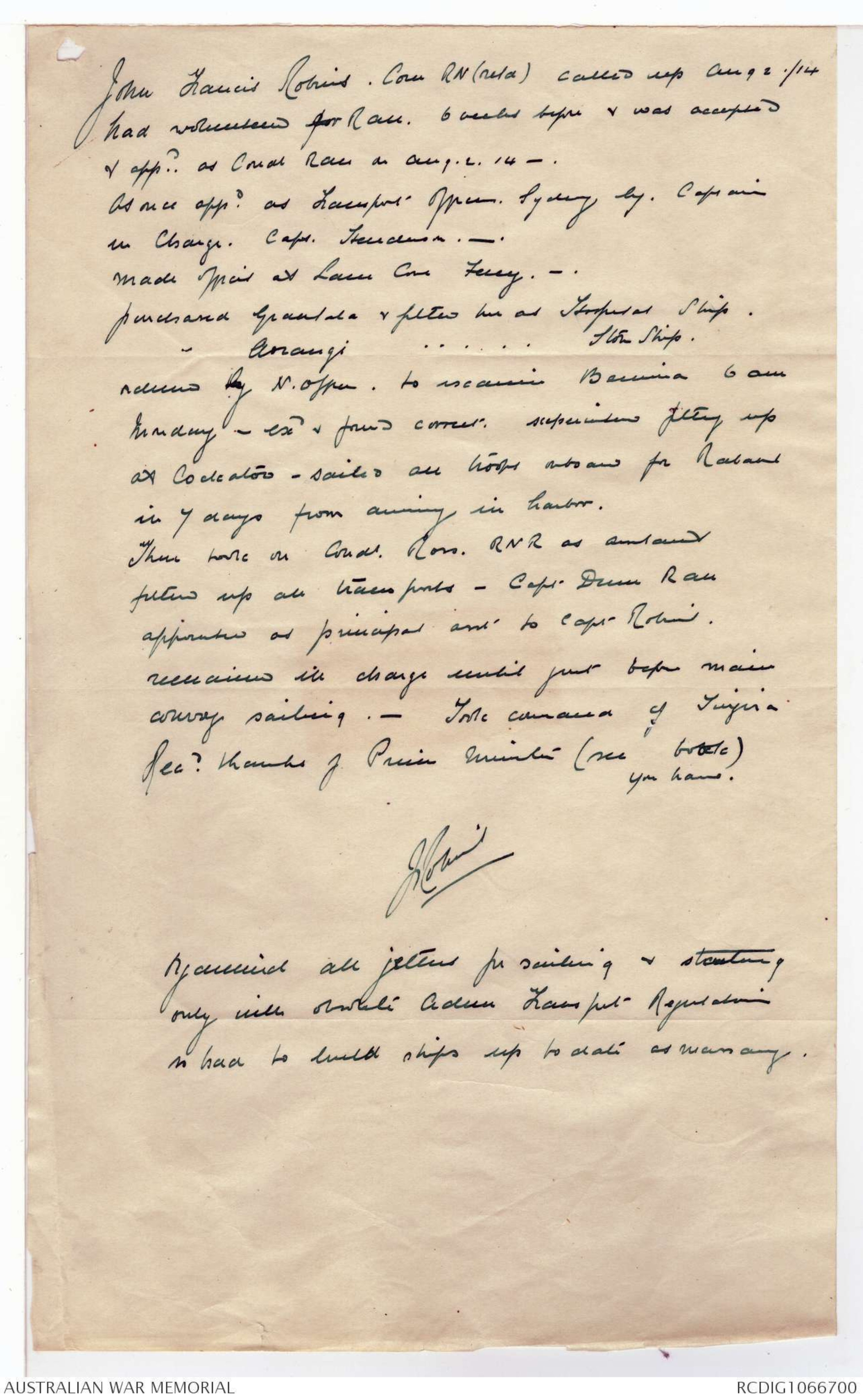
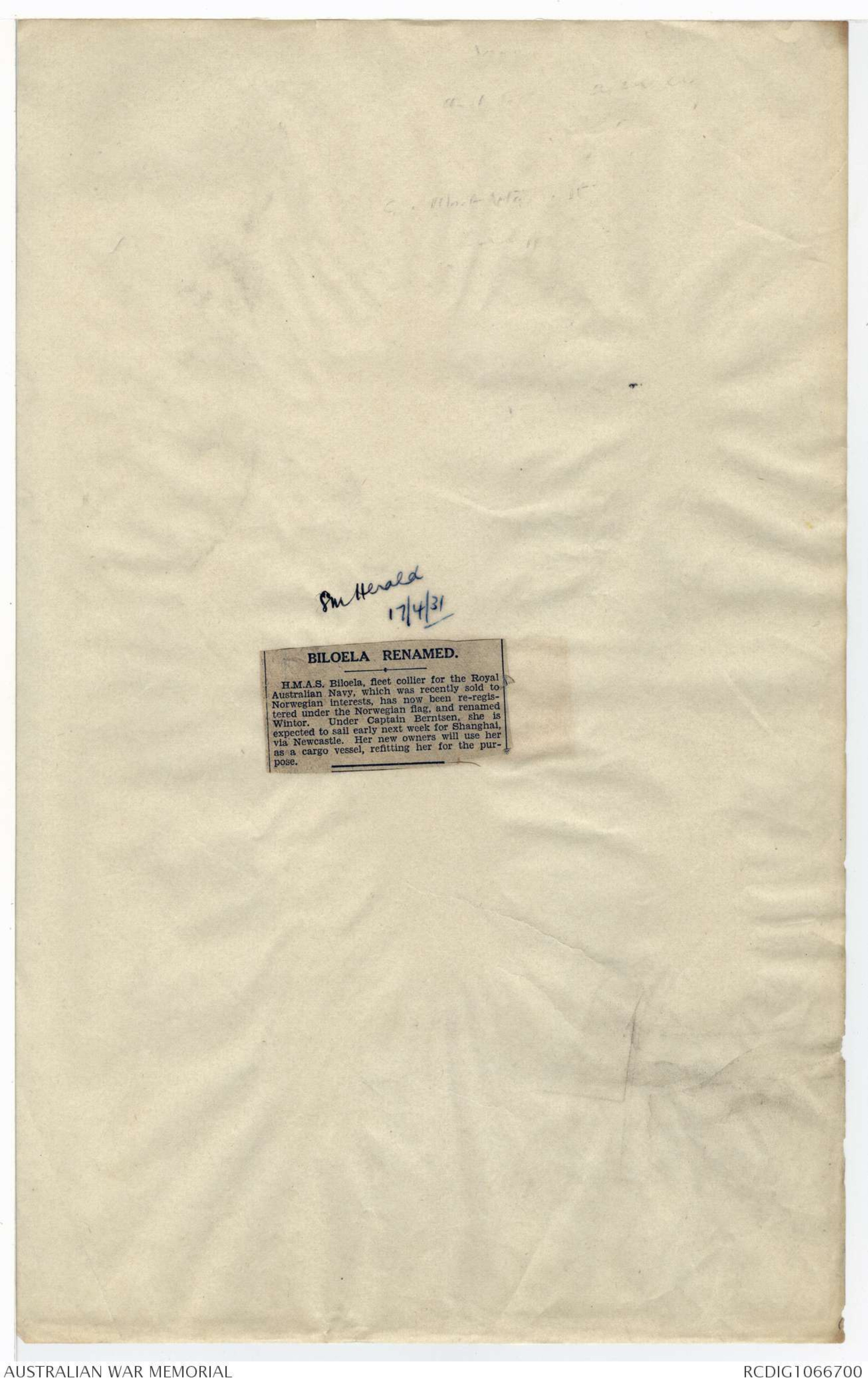
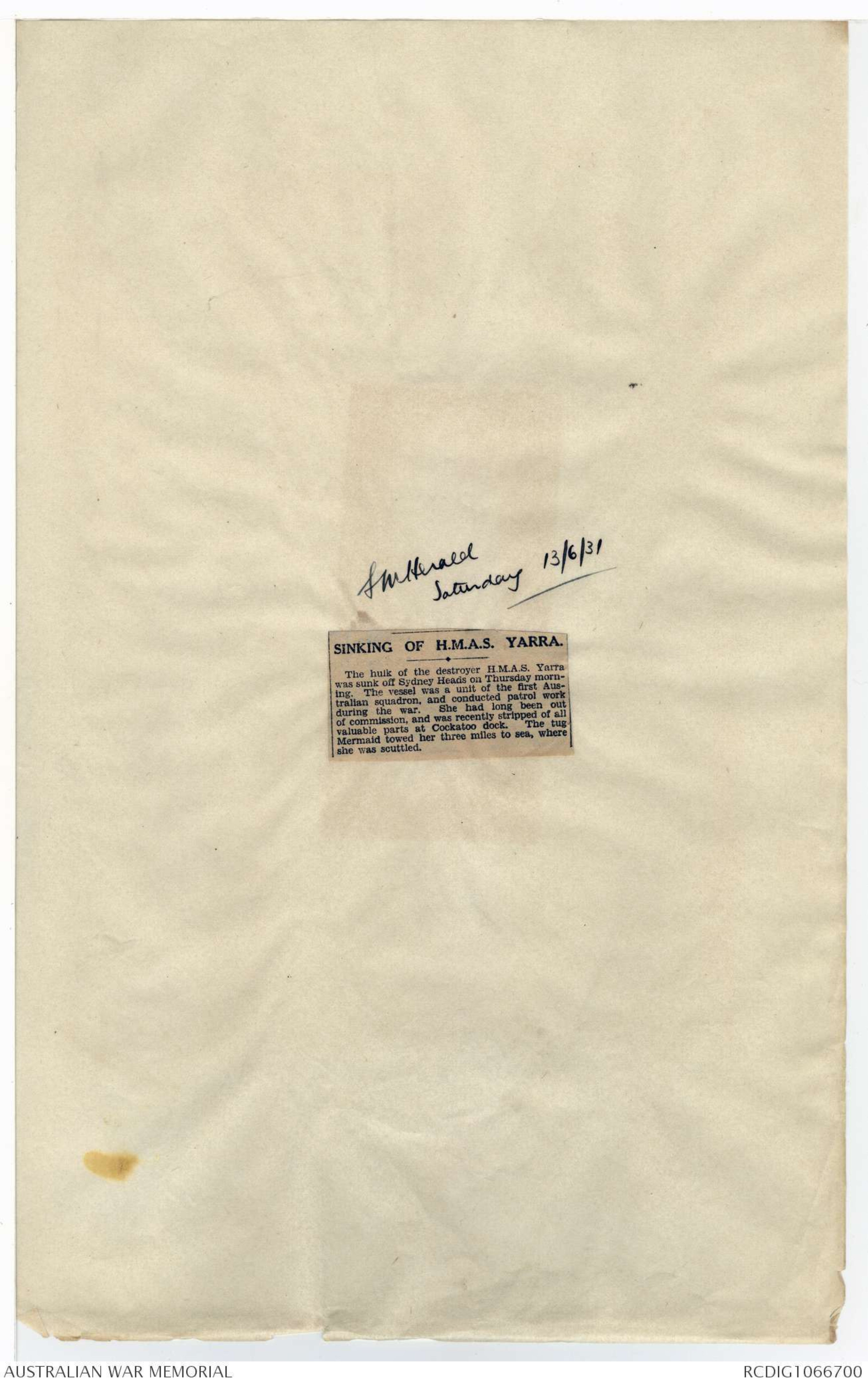
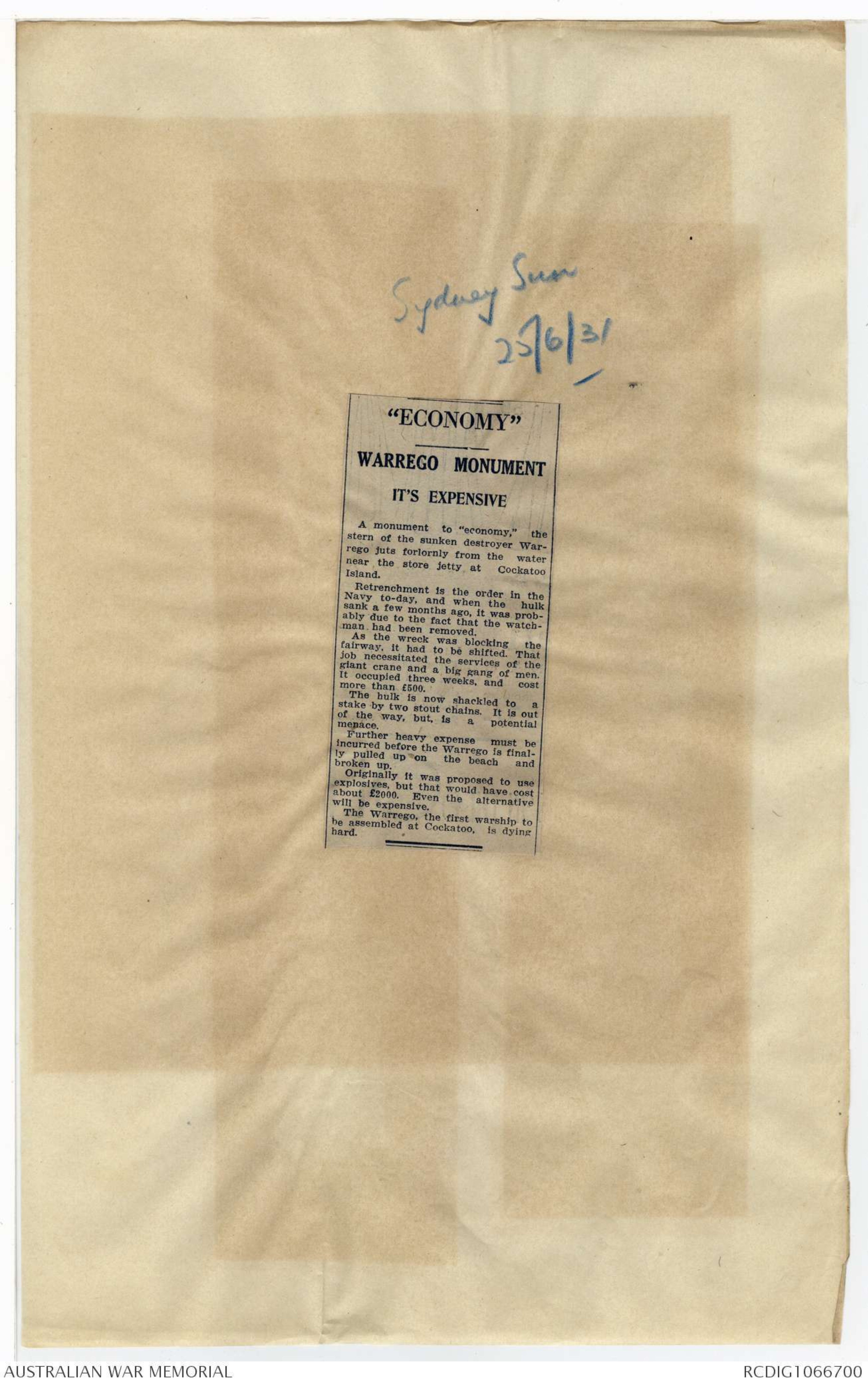
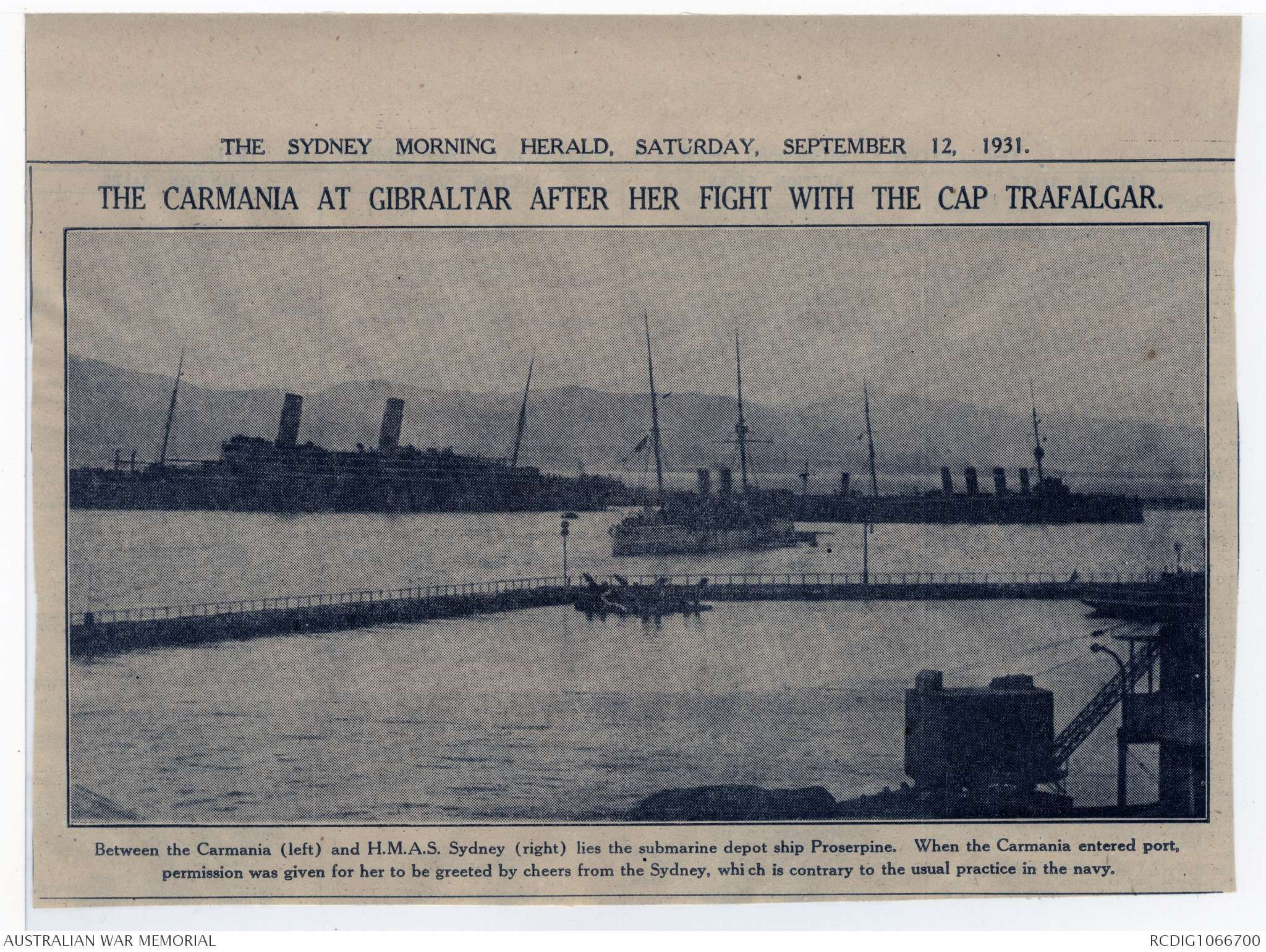
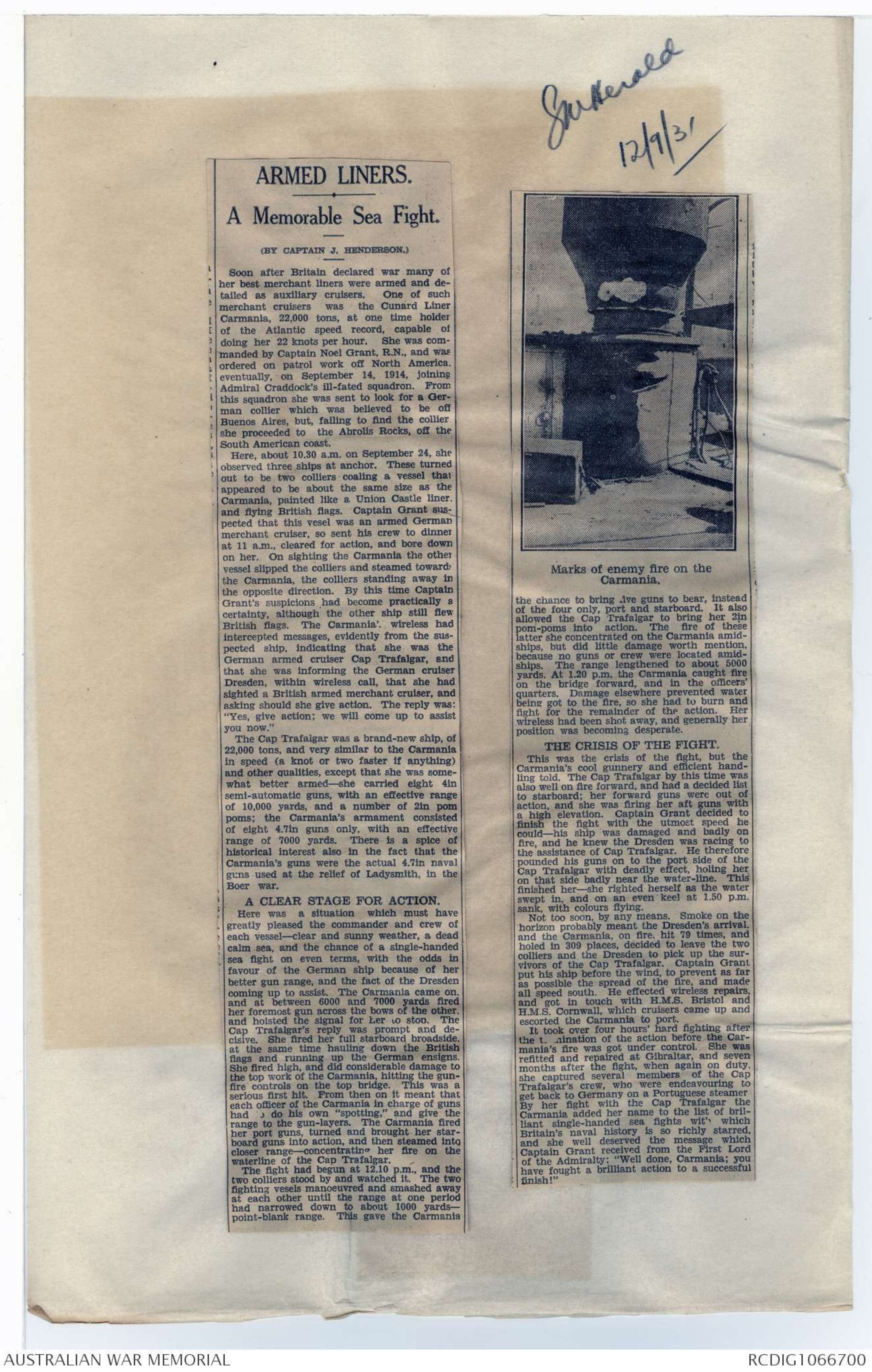
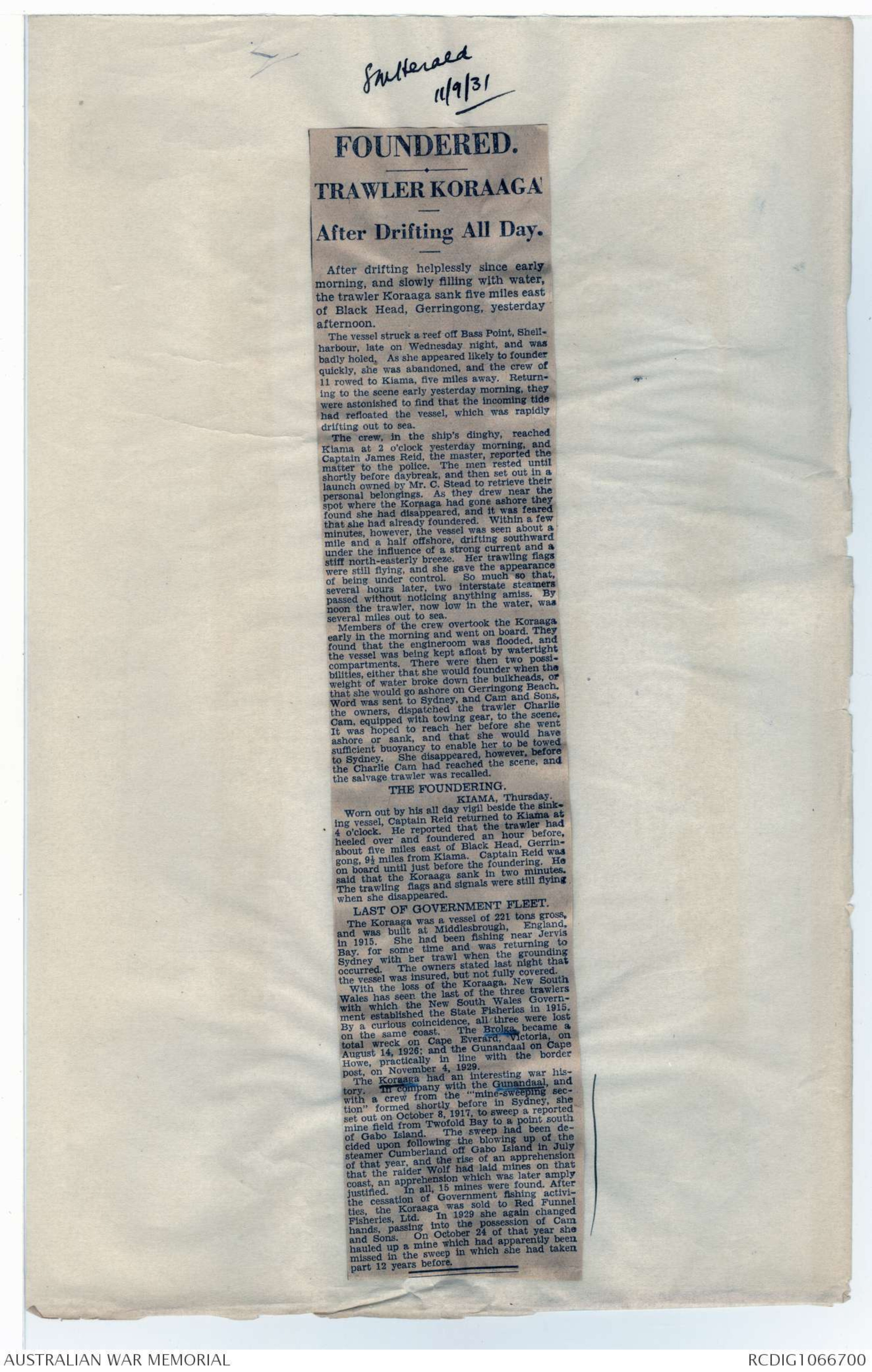
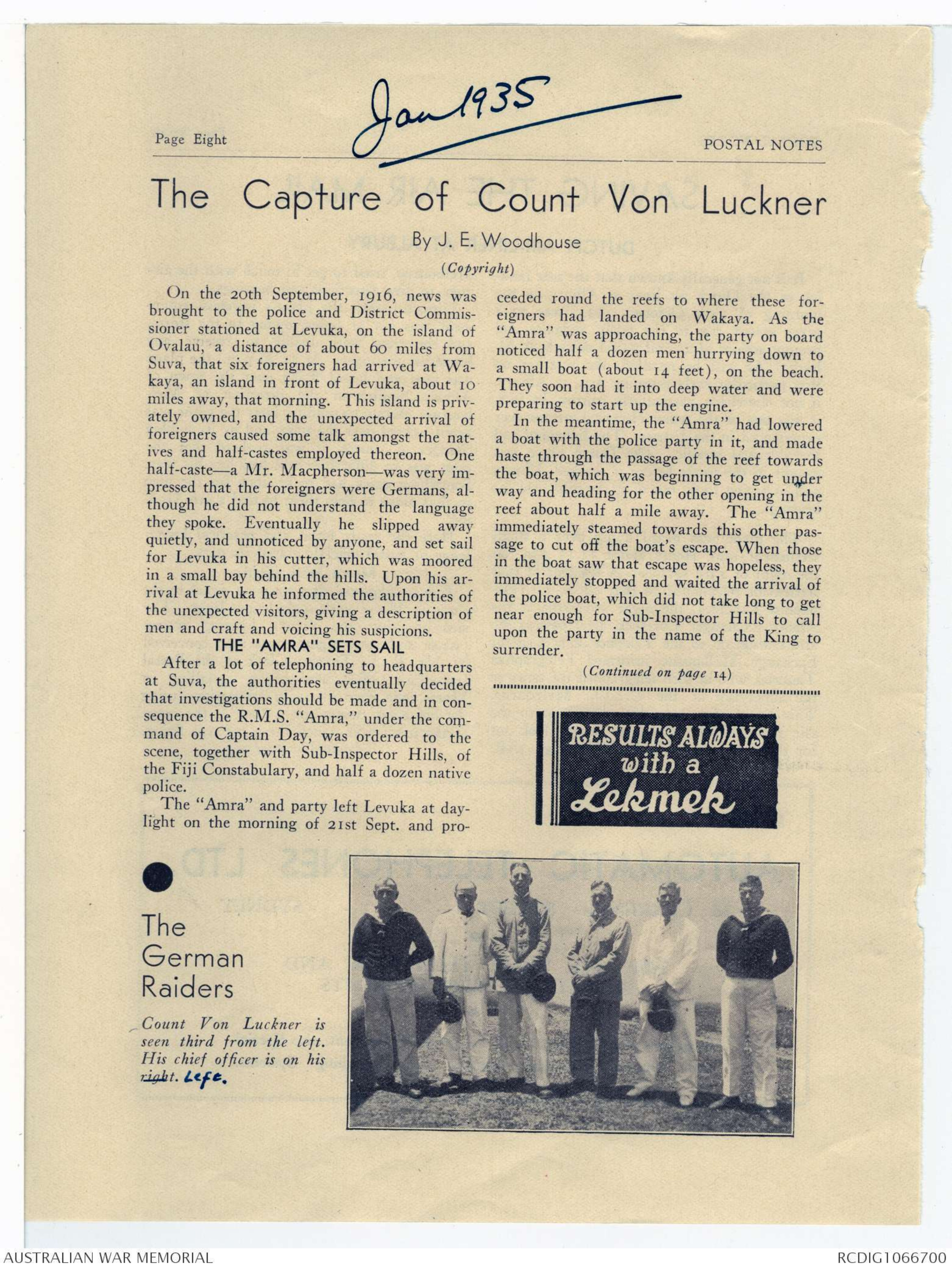

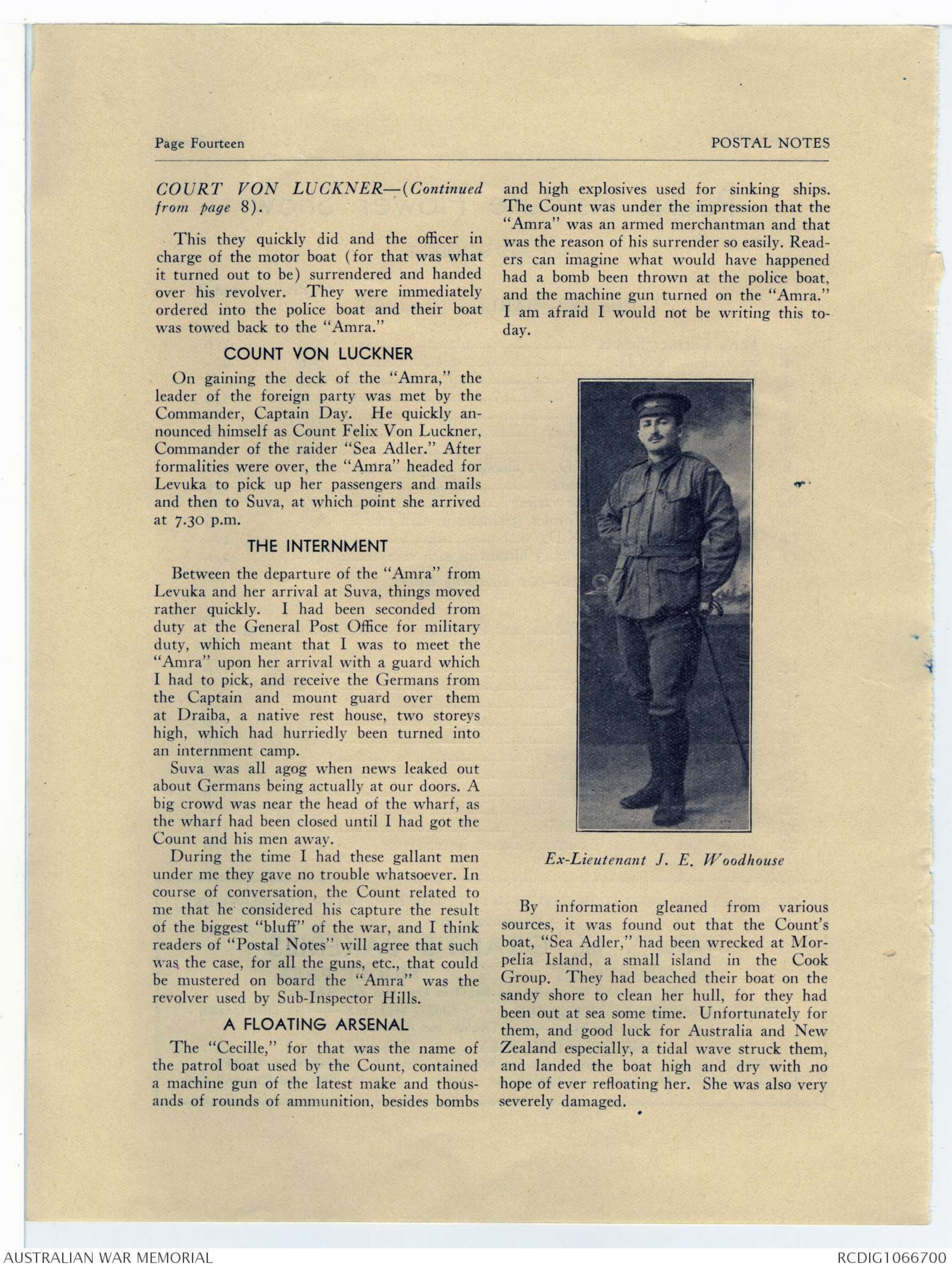
John Francis Robins. Com RN (retd) called up Aug 2 /14
had volunteered for Ran. 6 weeks before & was accepted
& appd as Comr Ran on Aug 2. 14 -
At once appd as Transport Officer Sydney by. Captain
in Charge. Capt. [[?]]
Made officer at Lane Cove [[?]].
purchased Grantala & fitted her as Hospital Ship .
" Aorangi " " " Store Ship.
[[/] by N. officer. to examine [[?]] 6am
Monday - exd & found correct. Supervisor fitting up
at Cockatoo - sailed all troops onto and for Rabaul
in 7 days from arriving in harbor.
Then took on [[Condl.?]] Ross. RNR as assistant
fitted up as transports - Capt Dunn Ran
appointed as principal asst to Capt Robins.
remained in charge until just before main
convoy sailing. - Took command of Tingira
Recd thanks of Prime Minister (See book
you have.)
JRobins
[[?]] all [[?]] for sailing and stationing
only with obsolete Admin Transport Regulations
so had to build ships up to date as [[?]]
[*SM Herald 17/4/31*]
BILOELA RENAMED.
H.M.A.S. Biloela, fleet collier for the Royal
Australian Navy, which was recently sold to
Norwegian interests, has now been re-registered
under the Norwegian flag, and renamed
Wintor. Under Captain Berntsen, she is
expected to sail early next week for Shanghai,
via Newcastle. Her new owners will use her
as a cargo vessel, refitting her for the purpose.
[*SM Herald
Saturday 13/6/31*]
SINKING OF H.M.A.S. YARRA.
The hulk of the destroyer H.M.A.S. Yarra
was sunk off Sydney Heads on Thursday morning.
The vessel was a unit of the first Australian
squadron, and conducted patrol work
during the war. She had long been out
of commission, and was recently stripped of all
valuable parts at Cockatoo dock. The tug
Mermaid towed her three miles to sea, where
she was scuttled.
[*Sydney Sun
25/6/31*]
"ECONOMY"
WARREGO MONUMENT
IT'S EXPENSIVE
A monument to "economy," the
stern of the sunken destroyer Warrego
juts forlornly from the water
near the store jetty at Cockatoo
Island.
Retrenchment is the order in the
Navy to-day, and when the hulk
sank a few months ago, it was probably
due to the fact that the watchman
had been removed.
As the wreck was blocking the
fairway, it had to be shifted. That
job necessitated the services of the
giant crane and a big gang of men.
It occupied three weeks, and cost
more than £500.
The hulk is now shackled to a
stake by two stout chains. It is out
of the way, but, is a potential
menace.
Further heavy expense must be
incurred before the Warrego is finally
pulled up on the beach and
broken up.
Originally it was proposed to use
explosives but that would have cost
about £2000. Even the alternative
will be expensive.
The Warrego, the first warship to
be assembled at Cockatoo, is dying
hard.
THE SYDNEY MORNING HERALD, SATURDAY, SEPTEMBER 12, 1931
THE CARMANIA AT GIBRALTAR AFTER HER FIGHT WITH THE CAP TRAFALGAR.
Photograph - see original document
Between the Carmania (left) and H.M.A.S. Sydney (right) lies the submarine depot ship Proserpine. When the Carmania entered port,
permission was given for her to be greeted by cheers from the Sydney, which is contrary to the usual practice in the navy.
[*SM Herald 12/9/31*]
as auxiliary cruisers. One of such
collier which was believed to be off
She fired her full starboard broadside,
guns into action, and then steamed into
amidships, but did little damage worth mention,
told. The Cap Trafalgar by this time was
of the Cap Trafalgar. Captain Grant
Carmania's fire was got under control. She was
brilliant single-handed sea fights with which
[*SM Herald
11/9/31*]
to the scene early yesterday morning, they
either that she would founder when the
vessel, Captain Reid returned to Kiama at
9½ miles from Kiama. Captain Reid was
established the State Fisheries in 1915.
formed shortly before in Sydney, she
upon following the blowing up of the
the Koraaga was sold to Red Funnel
[*Jan 1935*]
Page Eight POSTAL NOTES
The Capture of Count Von Luckner
By J. E. Woodhouse
(Copyright)
On the 20th September 1916, news was
brought to the police and District Commissioner
stationed at Levuka, on the island of
Ovalau, a distance of about 60 miles from
Suva, that six foreigners had arrived at Wakaya,
an island in front of Levuka, about 10
miles away, that morning. The island is privately
owned, and the unexpected arrival of
foreigners caused some talk amongst the natives
and half-castes employed thereon. One
half-caste—a Mr Macpherson—was very
impressed that the foreigners were Germans,
although he did not understand the language
they spoke. Eventually he slipped away
quietly, and unnoticed by anyone, and set sail
for Levuka in his cutter, which was moored
in a small bay behind the hills. Upon his
arrival at Levuka he informed the authorities of
the unexpected visitors, giving a description of
en and craft and voicing his suspicions.
THE "AMRA" SETS SAIL
After a lot of telephoning to headquarters
at Suva, the authorities eventually decided
that investigations should be made and in
consequence the R.M.S. "Amra", under the
command of Captain Day, was ordered to the
scene, together wth Sub-Inspector Hills of
the Fiji Constabulary, and half a dozen native
police.
The "Amra" and party left Levuka at daylight
on the morning of 21st Sept. and proceeded
around the reefs to where these foreigners
had landed on Wakaya. As the
"Amra" was approaching, the party on board
noticed half a dozen men hurrying down
to a small boat (about 14 feet), on the beach.
They soon had it into deep water and were
preparing to start up the engine.
In the meantime, the "Amra" had lowered
a boat with the police party on it, and made
haste through the passage of the reef towards
the boat, which was beginning to get under
way and heading for the other opening in the
reef about half a mile away. The "Amra"
immediately steamed towards this other
passage to cut off the boat's escape. When those
in the boat saw that escape was hopeless, they
immediately stopped and waited the arrival of
the police boat, which did not take long to get
near enough for Sub-Inspector Hills to call
upon the party in the name of the King to surrender.
(Continued on page 14)
Photograph - see original document
The German Raiders
Count Von Luckner is
seen third from the left.
His chief officer is on hisright left.
POSTAL NOTES Page Seven
SAVING THE AIR MAIL
DUTCH AIR-LINER AT ALBURY
It is not generally known that the safe landing
of the Dutch air liner at Albury on the
morning of 24th October, 1934, was to
a great extent due to the ready response and
prompt actions of several postal officials at
Albury. As will be recalled, the weather on
that particular morning was, at Albury,
if not elsewhere, particularly stormy. In fact,
it was one of the worst electrical storms ever
experienced in the district. The lightning and
thunder was terrific. The Dutch plane
was caught in the storm before it reached Albury,
and in trying to fly out of it the pilot lost his
bearings.
The plane was heard flying over a small
settlement near Henty about 11.15 p.m. on
the night of 23rd October. A resident of that
settlement telephoned to that effect, to Telephonist
Lovelock, the night attendant at the
Albury Exchange. Lovelock, after passing the
information on to the Telephonist at Central
Exchange, Melbourne, informed Telegraphist
Tancred, who in turn telegraphed the news to
the Supervisor at the C.T.O., Melbourne.
This information was then passed on to the
Air Race officials, who were on the look out
for the Dutch plane, and who through 3AR,
Melbourne, tried to get in touch with the airmen,
to give directions and bearings.
Unfortunately, the plane's wireless equipment
was out of order, owing to the storm,
and the crew were unable to receive any
broadcast messages. At 11.30 p.m., the plane
was seen and heard flying over the town of
Albury, heading in the direction of Melbourne.
About 10 minutes later the plane was
again sighted over the town and by its sudden
changes of course, it was realised that the
pilot was in difficulties and had lost his way.
Something quick had to be done for the men
in that plane to help them to find a safe landing.
Here the ready brain and practical knowledge
of postal officials played its part.
Morse with Lights
It was suggested that someone signal to the
plane in Morse with some bright light. The
idea of using the town's lighting system
(street and other lights) was then conceived
by Mr. R. F. Turner, Clerk at the Postal
Inspector's Office, who began signalling in
Morse code from the main sub-station (using
the big main switch for a "key"), the name
of the town over which the plane was flying.
(Continued on page 11)
Page Fourteen POSTAL NOTES
COURT VON LUCKNER -- (Continued
from page 8.)
This they quickly did and the officer
in charge of the motor boat (for that was what
it turned out to be) surrendered and handed
over his revolver. They were immediately
ordered into the police boat and their boat
was towed back to the "Amra."
COUNT VON LUCKNER
On gaining the deck of the "Amra," the
leader of the foreign party was met by the
Commander, Captain Day. He quickly
announced himself as Count Felix Von Luckner,
Commander of the raider "Sea Adler." After
formalities were over, the "Amra" headed for
Levuka to pick up her passengers and mails
and then to Suva, at which point she arrived
at 7.30 p.m.
THE INTERNMENT
Between the departure of the "Amra" from
Levuka and her arrival at Suva, things moved
rather quickly. I had been seconded from
duty at the General Post Office for military
duty, which meant that I was to meet the
"Amra" upon her arrival with a guard which
I had to pick, and receive the Germans from
the Captain and mount guard over them
at Draiba, a native rest house, two storeys
high, which had hurriedly been turned into
an internment camp.
Suva was all agog when news leaked out
about Germans being actually at our doors. A
big crowd was near the head of the wharf, as
the wharf had been closed until I had got the
Count and his men away.
During the time I had these gallant men
under me they gave me no trouble whatsoever. In
course of conversation, the Count related to
me that he considered his capture the result
of the biggest "bluff" of the war, and I think
readers of "Postal Notes" will agree that such
was the case, for all the guns etc., that could
be mustered on board the "Amra" was the
revolver used by Sub-Inspector Hills.
A FLOATING ARSENAL
The "Cecille", for that was the name of
the patrol boat used by the Count, contained a
machine gun of the latest make and thousands
of rounds of ammunition, besides bombs
and high explosives used for sinking ships.
The Count was under the impression that the
"Amra" was an armed merchantman and that
was the reason of his surrender so easily. Readers
can imagine what would have happened
had a bomb been thrown at the police boat,
and the machine gun turned on the "Amra".
I am afraid I would not be writing this today.
Photograph - see original document
Ex-Lieutenant J. E. Woodhouse
By information gleaned from various
sources, it was found out that the Count's
boat, "Sea Adler" had been wrecked at Morpelia
Island, a small island in the Cook
Group. They had beached their boat on the
sandy shore to clean her hull, for they had
been out at sea some time. Unfortunately for
them, and good luck for the Australia and New
Zealand especially, a tidal wave struck them,
and landed the boat high and dry with no
hope of ever refloating her. She was also very
severely damaged.
 Helen Martin
Helen MartinThis transcription item is now locked to you for editing. To release the lock either Save your changes or Cancel.
This lock will be automatically released after 60 minutes of inactivity.